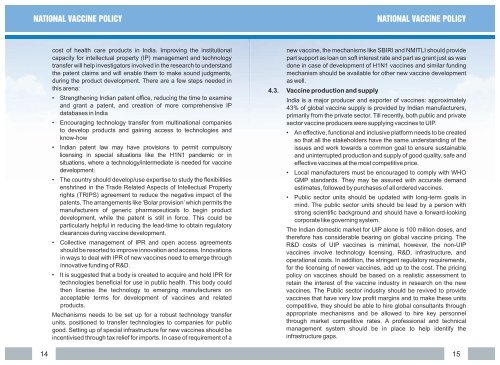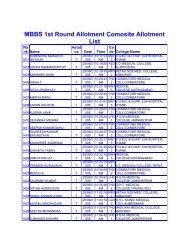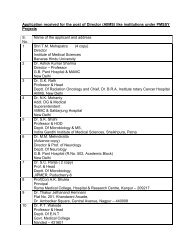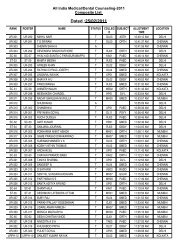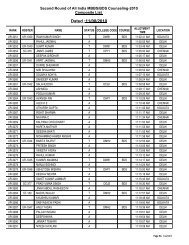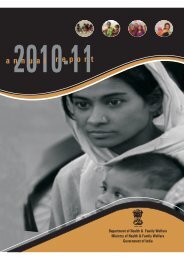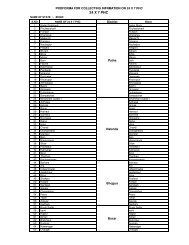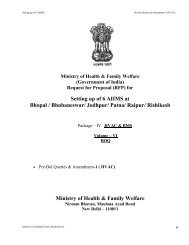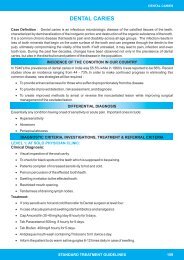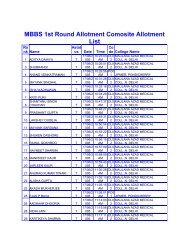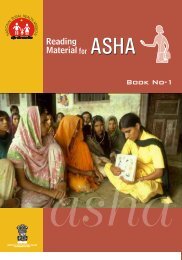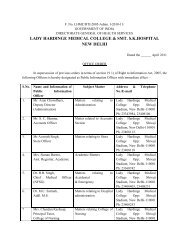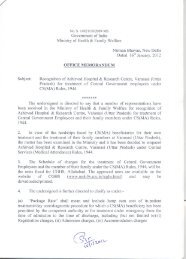National Vaccine Policy Book - Ministry of Health and Family Welfare
National Vaccine Policy Book - Ministry of Health and Family Welfare
National Vaccine Policy Book - Ministry of Health and Family Welfare
You also want an ePaper? Increase the reach of your titles
YUMPU automatically turns print PDFs into web optimized ePapers that Google loves.
cost <strong>of</strong> health care products in India. Improving the institutional<br />
capacity for intellectual property (IP) management <strong>and</strong> technology<br />
transfer will help investigators involved in the research to underst<strong>and</strong><br />
the patent claims <strong>and</strong> will enable them to make sound judgments,<br />
during the product development. There are a few steps needed in<br />
this arena:<br />
• Strengthening Indian patent <strong>of</strong>fice, reducing the time to examine<br />
<strong>and</strong> grant a patent, <strong>and</strong> creation <strong>of</strong> more comprehensive IP<br />
databases in India<br />
• Encouraging technology transfer from multinational companies<br />
to develop products <strong>and</strong> gaining access to technologies <strong>and</strong><br />
know-how<br />
• Indian patent law may have provisions to permit compulsory<br />
licensing in special situations like the H1N1 p<strong>and</strong>emic or in<br />
situations, where a technology/intermediate is needed for vaccine<br />
development.<br />
• The country should develop/use expertise to study the flexibilities<br />
enshrined in the Trade Related Aspects <strong>of</strong> Intellectual Property<br />
rights (TRIPS) agreement to reduce the negative impact <strong>of</strong> the<br />
patents. The arrangements like ‘Bolar provision’ which permits the<br />
manufacturers <strong>of</strong> generic pharmaceuticals to begin product<br />
development, while the patent is still in force. This could be<br />
particularly helpful in reducing the lead-time to obtain regulatory<br />
clearances during vaccine development.<br />
• Collective management <strong>of</strong> IPR <strong>and</strong> open access agreements<br />
should be resorted to improve innovation <strong>and</strong> access. Innovations<br />
in ways to deal with IPR <strong>of</strong> new vaccines need to emerge through<br />
innovative funding <strong>of</strong> R&D.<br />
• It is suggested that a body is created to acquire <strong>and</strong> hold IPR for<br />
technologies beneficial for use in public health. This body could<br />
then license the technology to emerging manufacturers on<br />
acceptable terms for development <strong>of</strong> vaccines <strong>and</strong> related<br />
products.<br />
Mechanisms needs to be set up for a robust technology transfer<br />
units, positioned to transfer technologies to companies for public<br />
good. Setting up <strong>of</strong> special infrastructure for new vaccines should be<br />
incentivised through tax relief for imports. In case <strong>of</strong> requirement <strong>of</strong> a<br />
new vaccine, the mechanisms like SBIRI <strong>and</strong> NMITLI should provide<br />
part support as loan on s<strong>of</strong>t interest rate <strong>and</strong> part as grant just as was<br />
done in case <strong>of</strong> development <strong>of</strong> H1N1 vaccines <strong>and</strong> similar funding<br />
mechanism should be available for other new vaccine development<br />
as well.<br />
4.3. <strong>Vaccine</strong> production <strong>and</strong> supply<br />
India is a major producer <strong>and</strong> exporter <strong>of</strong> vaccines: approximately<br />
43% <strong>of</strong> global vaccine supply is provided by Indian manufacturers,<br />
primarily from the private sector. Till recently, both public <strong>and</strong> private<br />
sector vaccine producers were supplying vaccines to UIP.<br />
• An effective, functional <strong>and</strong> inclusive platform needs to be created<br />
so that all the stakeholders have the same underst<strong>and</strong>ing <strong>of</strong> the<br />
issues <strong>and</strong> work towards a common goal to ensure sustainable<br />
<strong>and</strong> uninterrupted production <strong>and</strong> supply <strong>of</strong> good quality, safe <strong>and</strong><br />
effective vaccines at the most competitive price.<br />
• Local manufacturers must be encouraged to comply with WHO<br />
GMP st<strong>and</strong>ards. They may be assured with accurate dem<strong>and</strong><br />
estimates, followed by purchases <strong>of</strong> all ordered vaccines.<br />
• Public sector units should be updated with long-term goals in<br />
mind. The public sector units should be lead by a person with<br />
strong scientific background <strong>and</strong> should have a forward-looking<br />
corporate like governing system.<br />
The Indian domestic market for UIP alone is 100 million doses, <strong>and</strong><br />
therefore has considerable bearing on global vaccine pricing. The<br />
R&D costs <strong>of</strong> UIP vaccines is minimal, however, the non-UIP<br />
vaccines involve technology licensing, R&D, infrastructure, <strong>and</strong><br />
operational costs. In addition, the stringent regulatory requirements,<br />
for the licensing <strong>of</strong> newer vaccines, add up to the cost. The pricing<br />
policy on vaccines should be based on a realistic assessment to<br />
retain the interest <strong>of</strong> the vaccine industry in research on the new<br />
vaccines. The Public sector industry should be revived to provide<br />
vaccines that have very low pr<strong>of</strong>it margins <strong>and</strong> to make these units<br />
competitive, they should be able to hire global consultants through<br />
appropriate mechanisms <strong>and</strong> be allowed to hire key personnel<br />
through market competitive rates. A pr<strong>of</strong>essional <strong>and</strong> technical<br />
management system should be in place to help identify the<br />
infrastructure gaps.<br />
14 15


